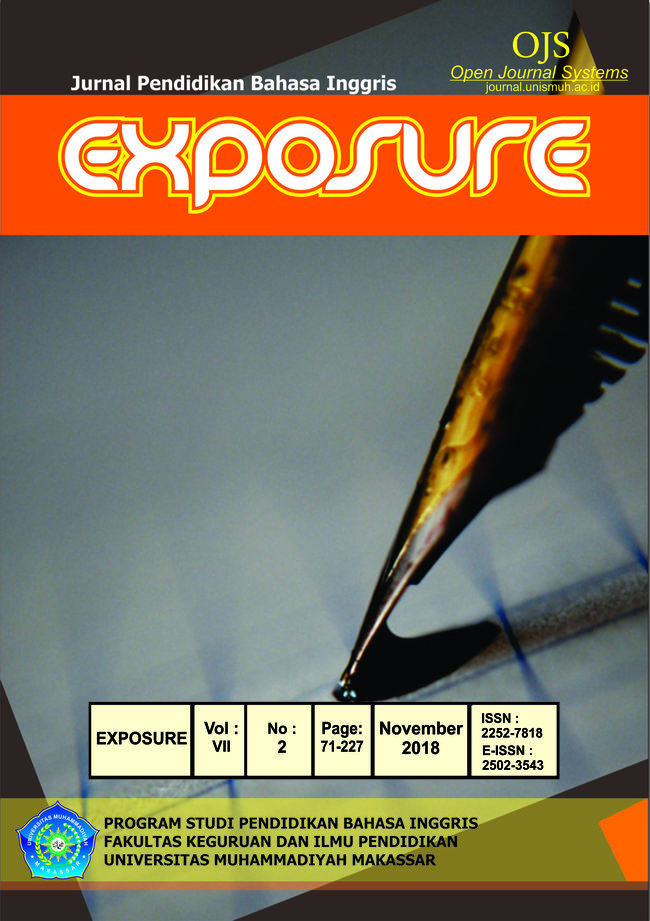THE IMPLEMENTATION OF SNAKE & LADDER BOARD GAME TO IMPROVE STUDENTS’ SPEAKING ABILITY
DOI:
https://doi.org/10.26618/exposure.v7i2.1575Kata Kunci:
Board Game, CAR, Speaking AbilityAbstrak
Speaking is a part of language skills which is really essential. Among other skills, speaking is mostly used to communicate with people. The aim of this research was to observe and know the improvement of students’ speaking ability at the second semester students of English Language Education Department, University of Muhammadiyah Malang. There were 24 students under observation. This research employed Classroom second semester students of English Language Education Department, University of Muhammadiyah Malang Action Research (CAR). The researcher implemented two cycles in this research. The first cycle (cycle 1) covered two meetings while cycle two covered three meetings. The test for the students’ speaking performance at cycle 1 showed that the average score of the speaking performance test was 69.92. The standard deviation yielded 4. Meanwhile, the lowest and the highest score were 62 and 78 respectively. At the cycle 2 test, the result showed the average score of the speaking test was 76.50. standard deviation yielded 2. Furthermore, the highest and the lowest score were 80 and 73 respectively. From the cycle 2 result, it proved that the implementation of snake & ladder board game could improve the speaking ability of the students at English Language Education Department, University of Muhammadiyah Malang.
Unduhan
Diterbitkan
Terbitan
Bagian
Lisensi
Authors who publish with this journal agree to the following terms:
In order to assure the highest standards for published articles, a peer review policy is applied. In pursue of the compliance with academic standards, all parties involved in the publishing process (the authors, the editors and the editorial board and the reviewers) agree to meet the responsibilities stated below in accordance to the Journal publication ethics and malpractice statement.
Duties of Authors:
- The author(s) warrant that the submitted article is an original work, which has not been previously published, and that they have obtained an agreement from any co-author(s) prior to the manuscript’s submission;
- The author(s) should not submit articles describing essentially the same research to more than one journal;
- The authors(s) make certain that the manuscript meets the terms of the Manuscript Submission Guideline regarding appropriate academic citation and that no copyright infringement occurs;
- The authors(s) should inform the editors about any conflict of interests and report any errors they subsequently, discover in their manuscript.
Duties of Editors and the Editorial Board:
- The editors, together with the editorial board, are responsible for deciding upon the publication or rejection of the submitted manuscripts based only on their originality, significance, and relevance to the domains of the journal;
- The editors evaluate the manuscripts compliance with academic criteria, the domains of the journal and the guidelines;
- The editors must at all times respect the confidentiality of any information pertaining to the submitted manuscripts;
- The editors assign the review of each manuscript to two reviewers chosen according to their domains of expertise. The editors must take into account any conflict of interest reported by the authors and the reviewers.
- The editors must ensure that the comments and recommendations of the reviewers are sent to the author(s) in due time and that the manuscripts are returned to the editors, who take the final decision to publish them or not.
Authors are permitted and encouraged to post online a pre-publication manuscript (but not the Publisher’s final formatted PDF version of the Work) in institutional repositories or on their Websites prior to and during the submission process, as it can lead to productive exchanges, as well as earlier and greater citation of published work (see The Effect of Open Access). Any such posting made before acceptance and publication of the Work shall be updated upon publication to include a reference to the Publisher-assigned DOI (Digital Object Identifier) and a link to the online abstract for the final published Work in the Journal.

